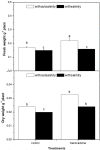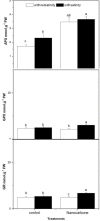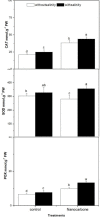Synergistic effect of carbon nanoparticles with mild salinity for improving chemical composition and antioxidant activities of radish sprouts
- PMID: 37324721
- PMCID: PMC10264676
- DOI: 10.3389/fpls.2023.1158031
Synergistic effect of carbon nanoparticles with mild salinity for improving chemical composition and antioxidant activities of radish sprouts
Abstract
The demand for healthy foods with high functional value has progressively increased. Carbon nanoparticles (CNPs) have a promising application in agriculture including the enhancement of plant growth. However, there are few studies on the interactive effects of CNPs and mild salinity on radish seed sprouting. To this end, the effect of radish seed priming with 80mM CNPs on biomass, anthocyanin, proline and polyamine metabolism, and antioxidant defense system under mild salinity growth condition (25 mM NaCl). The results indicated that seed nanopriming with CNPs along with mild salinity stress enhanced radish seed sprouting and its antioxidant capacity. Priming boosted the antioxidant capacity by increasing antioxidant metabolites such as (polyphenols, flavonoids, polyamines, anthocyanin, and proline). To understand the bases of these increases, precursors and key biosynthetic enzymes of anthocyanin [phenylalanine, cinnamic acid, coumaric acid, naringenin, phenylalanine ammonia lyase, chalcone synthase (CHS), cinnamate-4-hydroxylase (C4H) and 4-coumarate: CoA ligase (4CL)], proline [pyrroline-5-carboxylate synthase (P5CS), proline dehydrogenase (PRODH), Sucrose, Sucrose P synthase, invertase) and polyamines [putrescine, spermine, spermidine, total polyamines, arginine decarboxylase, orinthnine decarboxylase, S-adenosyl-L-methionine decarboxylase, spermidine synthase, spermine synthase] were analyzed. In conclusion, seed priming with CNPs has the potential to further stimulate mild salinity-induced bioactive compound accumulation in radish sprouts.
Keywords: anthocyanin; carbon nanoparticles; mild salinity; polyamines; proline; radish sprouts.
Copyright © 2023 Halawani, AbdElgawad, Aloufi, Balkhyour, Zrig and Hassan.
Conflict of interest statement
The authors declare that the research was conducted in the absence of any commercial or financial relationships that could be construed as a potential conflict of interest.
Figures





References
-
- Abbasi Khalaki M., Moameri M., Asgari Lajayer B., Astatkie T. (2021). Influence of nano-priming on seed germination and plant growth of forage and medicinal plants. Plant Growth Regul. 93, 13–28. doi: 10.1007/s10725-020-00670-9 - DOI
-
- Abdelgawad H., De Vos D., Zinta G., Domagalska M. A., Beemster G. T., Asard H. (2015). Grassland species differentially regulate proline concentrations under future climate conditions: an integrated biochemical and modelling approach. New Phytol. 208, 354–369. doi: 10.1111/nph.13481 - DOI - PMC - PubMed
LinkOut - more resources
Full Text Sources
Miscellaneous

